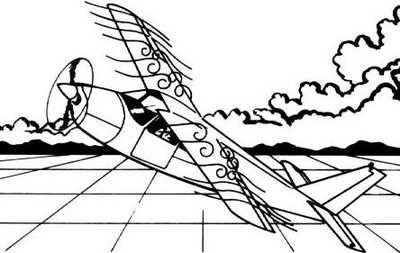Mon, Dec 25, 2006
Aero-Tips!
A good pilot is always learning -- how many times have you heard
this old standard throughout your flying career? There is no truer
statement in all of flying (well, with the possible exception of
"there are no old, bold pilots.")

Aero-News has called upon the expertise of Thomas P. Turner,
master CFI and all-around-good-guy, to bring our readers -- and us
-- daily tips to improve our skills as aviators. Some of them, you
may have heard before... but for each of us, there will also be
something we might never have considered before, or something that
didn't "stick" the way it should have the first time we memorized
it for the practical test.
Look for our daily Aero-Tips segments, coming each day to you
through the Aero-News Network.
Aero-Tips 12.25.06
Most airplanes have some sort of stall warning system.

- Aerodynamic warning. As the wing nears the
critical angle of attack, in most airplanes you'll begin to feel
vibration, the "buffet". Depending on the airfoil design you may
feel a strong, obvious buffet before the stall, or the wing may
stall completely with little to no warning.
- Artificial stall warning devices. Not required
until a few years after World War Two, artificial stall warning
devices are designed to give the pilot advance warning of reaching
the critical angle of attack. The first stall warning devices were
visual, usually a red light in the pilot's field of view. Later the
industry standardized on stall warning horns. In typical
installation stall warning devices are rigged to activate when the
indicated airspeed decreases to five to seven knots above indicated
stalling speed.
- Some larger airplanes have "stick shaker"
devices that artificially reproduce an aerodynamic stall
warning, when the "real" aerodynamic feel does not give an adequate
indication. In some airplanes this may be accompanied by an audible
warning; advanced airplanes will actually "push" forward on the
controls, reducing angle of attack and unloading the wing, if the
pilot does not respond to the stick shaker.
- Modifications to the wing (intentional, like
installation of vortex generators or Short Takeoff and Landing
[STOL] wingtips, or unintentional, like attempted flight with frost
or ice accumulation) may alter the warnings, and one or both wings
may stall before the original stall warning devices sound or
illuminate.
- Stall warnings may sound intermittently in turbulent
air. In fact, if flying below the airplane's Turbulent Air
Penetration Speed in moderate or greater turbulence, the wing is
supposed to momentarily stall as you encounter gusts, to prevent
overloading the wing and risking structural failure. It stands to
reason that the stall warning horn may chirp in this
occurrence.
- It's normal to hear the stall warning horn during your
landing flare. If you do everything right, especially a
short-field landing, you should penetrate this five-to-seven knot
warning activation range as the airplane settles to the ground.
Note: do NOT confuse this expected stall
warning activation in the flare with a similar-sounding gear-up
warning if flying a retractable gear airplane!
Aero-tip of the day: Anticipate when it's
expected to hear the indications of an impending stall, and take
action to return to a flying angle of attack at the first sign of
an unexpected stall warning.
More News
Omnidirectional Approach Lighting System ODALS consists of seven omnidirectional flashing lights located in the approach area of a nonprecision runway. Five lights are located on t>[...]
"Polaris Dawn, the first of the program’s three human spaceflight missions, is targeted to launch to orbit no earlier than summer 2024. During the five-day mission, the crew >[...]
Also: 1800th E-Jet, Uncle Sam Sues For Landing Gear, Embraer Ag Plane, Textron Parts A friend of the family reported that Lt. Col. (Ret.) Richard Glenn Rutan flew west on Friday, M>[...]
Also: Virgin Galactic, B-29 Doc to Allentown, Erickson Fire-Fighters Bought, FAA Reauthorization After dealing with a big letdown after the unexpected decision by Skyreach to disco>[...]
“Our aircrews are trained and capable of rapidly shifting from operational missions to humanitarian roles. We planned to demonstrate how we, and our BORSTAR partners, respond>[...]
 ANN's Daily Aero-Term (05.05.24): Omnidirectional Approach Lighting System
ANN's Daily Aero-Term (05.05.24): Omnidirectional Approach Lighting System Aero-News: Quote of the Day (05.05.24)
Aero-News: Quote of the Day (05.05.24) Airborne 05.06.24: Gone West-Dick Rutan, ICON BK Update, SpaceX EVA Suit
Airborne 05.06.24: Gone West-Dick Rutan, ICON BK Update, SpaceX EVA Suit Airborne 05.03.24: Advanced Powerplant Solutions, PRA Runway Woes, Drone Racing
Airborne 05.03.24: Advanced Powerplant Solutions, PRA Runway Woes, Drone Racing Aero-News: Quote of the Day (05.06xx.24)
Aero-News: Quote of the Day (05.06xx.24)




